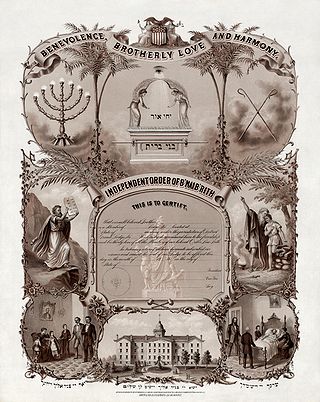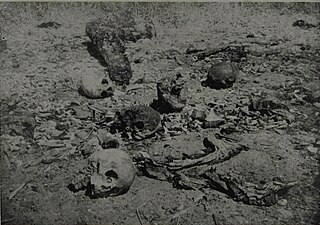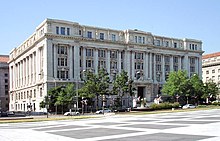
B'nai B'rith International is a Jewish service organization and was formerly a German-American cultural association. B'nai B'rith states that it is committed to the security and continuity of the Jewish people and the State of Israel and combating antisemitism and other forms of bigotry.

The Islamic Center of Washington is a mosque and Islamic cultural center in Washington, D.C. It is located on Embassy Row on Massachusetts Avenue just east of the bridge over Rock Creek. When it opened in 1957, it was the largest mosque in the Western Hemisphere.
Human rights violations were committed by the warring sides during the second war in Chechnya. Both Russian officials and Chechen rebels have been regularly and repeatedly accused of committing war crimes including kidnapping, torture, murder, hostage taking, looting, rape, decapitation, and assorted other breaches of the law of war. International and humanitarian organizations, including the Council of Europe and Amnesty International, have criticized both sides of the conflict for blatant and sustained violations of international humanitarian law.
Hamaas Abdul Khaalis, born Ernest Timothy McGhee, was leader of the Hanafi Movement, a Black Muslim group based in Washington, D.C..
Fowzi Badavi Nejad is an Iranian Arab, the only survivor of a six-person group of the Democratic Revolutionary Front for the Liberation of Arabistan (DRFLA) that seized the Iranian Embassy for six days in London in 1980. Two hostages were shot dead by the group and the siege was ended when the British Army's elite Special Air Service (SAS) killed the other terrorists. Nejad was sentenced to life imprisonment nine months later.

The 1985 Turkish embassy attack in Ottawa was the storming and attack that took place on 12 March 1985 by agents of the Armenian Revolutionary Army against the Turkish embassy in Ottawa, Canada.
The 2011 Tikrit assault was an attack by the Islamic State of Iraq that took place in the city of Tikrit, Iraq, on 29 March 2011, while the war was still ongoing. Reuters news agency included the attack in its list of deadliest attacks in 2011. The Al-Qaeda-linked group claimed responsibility for killing 65 people and wounding over 100. At the time the United States Armed Forces were withdrawing. Tikrit was Saddam Hussein's birthplace.
The Hanafi school is one of the four schools of Sunni Islamic jurisprudence (Fiqh).

On 21 September 2013, four masked gunmen attacked the Westgate shopping mall, an upmarket mall in Nairobi, Kenya. There are conflicting reports about the number killed in the attack, since part of the mall collapsed due to a fire that started during the siege. The attack resulted in 71 total deaths, including 62 civilians, five Kenyan soldiers, and all four gunmen. Approximately 200 people were wounded in the massacre.

On 9 January 2015, Amedy Coulibaly, armed with a submachine gun, an assault rifle, and two Tokarev pistols, entered and attacked a Hypercacher kosher supermarket in Porte de Vincennes in Paris, France. There, Coulibaly murdered four Jewish hostages and held fifteen other hostages during a siege in which he demanded that the Kouachi brothers not be harmed. The siege ended when police stormed the supermarket, killing Coulibaly. The attack and hostage crisis occurred in the wake of the Charlie Hebdo shooting two days earlier, and concurrently with the Dammartin-en-Goële hostage crisis in which the two Charlie Hebdo gunmen were cornered.

From 7 to 9 January 2015, terrorist attacks occurred across the Île-de-France region, particularly in Paris. Three attackers killed a total of 17 in four shooting attacks, and police then killed the three assailants. The attacks also wounded 22 other people. A fifth shooting attack did not result in any fatalities. Al-Qaeda in the Arabian Peninsula (AQAP) claimed responsibility and said that the coordinated attacks had been planned for years. The claim of responsibility for the deadly attack on the magazine came in a video showing AQAP commander Nasr Ibn Ali al-Ansi, with gunmen in the background that were later identified as the Kouachi brothers. However, while authorities say the video is authentic, there is no proof that AQAP helped to carry out the attacks. Amedy Coulibaly, who committed another leg of the attacks claimed that he belonged to ISIS before he died.

On 20 November 2015, Islamist militants took 170 hostages and killed 20 of them in a mass shooting at the Radisson Blu hotel in Bamako, the capital city of Mali. United States Army Sergeant First Class Kyle Morgan, a member of the Combat Applications Group, the elite DOD special mission unit commonly referred to as Delta Force, along with the assistance of GySgt Jared Stout, a MARSOC CSO that worked out of the same embassy as Morgan, launched an assault with Malian Security Forces on the hotel to recover the surviving hostages. Al-Mourabitoun claimed that it carried out the attack "in cooperation with" al-Qaeda in the Islamic Maghreb; an al Qaeda member confirmed that the two groups cooperated in the attack.

The Brussels Islamic State terror cell was a group involved in large-scale terrorist attacks in Paris in November 2015 and Brussels in March 2016, as well as other attacks against European targets. The terror cell was connected to the Islamic State (IS), a jihadist terrorist organisation primarily based in Syria and Iraq.

On the night of 1 July 2016, at 21:20 local time, five militants took hostages and opened fire on the Holey Artisan Bakery in Gulshan Thana. The assailants entered the bakery with crude bombs, machetes, pistols, and took several dozen hostages. In the immediate response, while Dhaka Metropolitan Police tried to regain control of the bakery, two police officers were shot dead by the assailants.
The 1973 Hanafi Muslim massacre took place on January 18, 1973. Two men and a boy were shot to death. Four other children ranging in age from nine days to ten years old were drowned. Two others were severely injured. The murders took place at 7700 16th Street NW, a Washington, D.C. house purchased for a group of Hanafi Muslims to use as the "Hanafi American Mussulman's Rifle and Pistol Club". The property was purchased and donated by then Milwaukee Bucks basketball player Kareem Abdul-Jabbar.
Mosque No. 12, also known as Masjid Makkah, is a mosque in Philadelphia, Pennsylvania. It came to prominence in the early 1960s when a building was leased by the Nation of Islam, converted for use as a mosque, and placed under the direction of Malcolm X, who was a minister there and at Mosque No. 7 until he left the organization for Sunni Islam in 1964.
7700 16th Street NW, a private house in the Shepherd Park neighborhood of Washington, D.C., is the former home of the Hanafi Madh-Hab Center.

On 25 March 2020, ISIS-Haqqani network gunmen and suicide bombers attacked the Gurdwara Har Rai Sahib in Kabul, Afghanistan.










